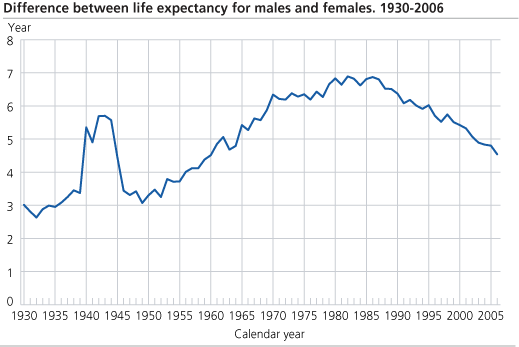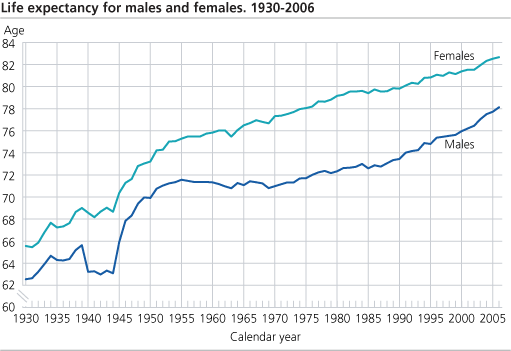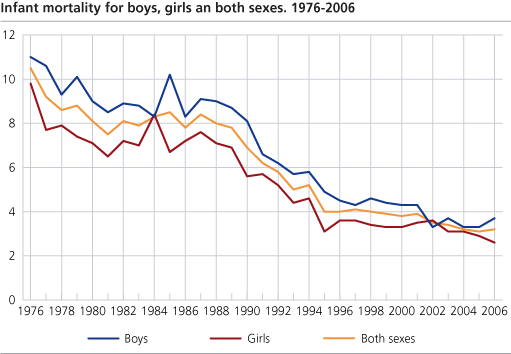Content
Published:
This is an archived release.
Gender gap in life expectancy narrows
Women still live longest, but the difference in life expectancy between men and women has fallen by one third in the last twenty years, to 4.5 years in 2006. Life expectancy continues to increase for both men and women. In 2006, a newborn girl could expect to live to just over 82 years of age, whereas a newborn boy could expect to live to 78 years of age.
The difference in women and men’s life expectancy during the 1980s was stable at around 6.8 years, but a pronounced reduction since 1987 has brought it down to 4.5 years in 2006. The difference in life expectancy varied between 2.5 and 3.5 years for more than one hundred years, but from the mid 1950s towards 1980 it increased. Since then the trend has continued, and from 2005 to 2006 life expectancy increased by 0.4 years for men and slightly more than 0.1 years for women.
In Europe, Spain and Switzerland had the highest life expectancy in 2005, where women could expect to live to 83.9 years. Iceland had the highest life expectancy for men with 79.2 years. Japan still has the highest life expectancy in the world, with 85.5 years for women and 78.5 for men in 2005.
Still relatively few are dying - but most women
There were 41 250 deaths in Norway in 2006. This is on level with 2005 and 2004, which had the lowest number of deaths since the late 1970s, when the population was 600 000 lower. In 2006, more than 500 more women died than the year before. The reason why women still experience a continued increase in life expectancy is an ageing population.
In 2006, 21 600 women and 19 600 men died, i.e. more women than men died despite the fact that between four and eight per cent more boys are born than girls. Since the end of the 1990s, more women than men have died. The explanation is an increasing majority of women compared to men in the age groups where most people die.
Lowest infant mortality for girls ever recorded
In 2006, 185 children under one year of age died, 111 boys and 74 girls. The infant morality, i.e. the number of deaths below one year of age per 1 000 live births, has been stable at about 3.2 for the last three years. Infant mortality for girls in 2006 was 2.6, which is the lowest mortality ever recorded in Norway.
Tables:
- Table 1 Deaths and death rates 1961-2006
- Table 2 Age-specific death rates for males and females. 1971-2006
- Table 3 Life expectancy - remaining years for males and females at selected ages. 1866-2006 (Updated 30 October 2007)
- Table 4 Perinatal and infant mortality. 1956-2006
- Table 5 Life tables. 2006
- Table 6 Expectation of life for males and females at selected ages, by county. 1971-2005
Contact
-
Anders Sønstebø
E-mail: anders.sonstebo@ssb.no
tel.: (+47) 46 66 37 74
-
Magnus Haug
E-mail: magnus.haug@ssb.no
tel.: (+47) 40 81 14 91
-
Ane Margrete Tømmerås
E-mail: ane.tommeras@ssb.no
tel.: (+47) 91 99 29 62
-
Statistics Norway's Information Centre
E-mail: informasjon@ssb.no
tel.: (+47) 21 09 46 42
-
Oppdrag befolkningsstatistikk
E-mail: befolkning@ssb.no



